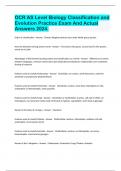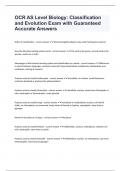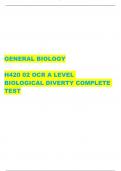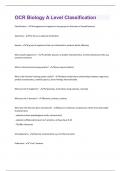Protoctista - Study guides, Class notes & Summaries
Looking for the best study guides, study notes and summaries about Protoctista? On this page you'll find 21 study documents about Protoctista.
All 21 results
Sort by

-
Bio 100 Exam 1 SBCC Questions and Answers Already Passed
- Exam (elaborations) • 15 pages • 2024
- Available in package deal
-
- $9.99
- + learn more
Bio 100 Exam 1 SBCC Questions and Answers Already Passed **Define Biology.** Biology is the scientific exploration of life. **What are the characteristics of Life?** Life is defined by traits such as (1) complex organization, (2) responsiveness to the environment, (3) reproduction, (4) evolution, (5) growth, (6) internal regulation, (7) homeostasis, and (8) energy processing. **Name the 5 Kingdoms.** The five kingdoms include Monera, Protoctista, Fungi, Plantae, and Animalia. ...

-
OCR AS Level Biology Classification and Evolution Practice Exam And Actual Answers 2024.
- Exam (elaborations) • 8 pages • 2024
- Available in package deal
-
- $7.99
- + learn more
Order of classification - Answer Domain kingdom phylum class order family genus species How the binomial naming system works - Answer First word is the genus, second word is the species, words are in Latin Advantages of the binomial naming system and classification as a whole - Answer Differences in names between languages, common names don't give detail about evolutionary relationships over continents, sharing of research Features used to classify Prokaryotae - Answer Unicellu...

-
Bio 100 Exam 1 SBCC Questions And Correct Answers |100% Verified |Guaranteed Success
- Exam (elaborations) • 8 pages • 2024
- Available in package deal
-
- $7.99
- + learn more
Biology - Answer-the scientific study of life Qualifications of Life - Answer-(1) Order/complex organization, (2) Response to environment, (3) Reproduction, (4) Evolution, (5) Growth, (6) Internal regulation, (7) Homeostasis, and (8) Energy processing The 5 Kingdoms - Answer-Monera, Protoctista, Fungi, Plantea, and Animalia The 3 Domains - Answer-Bacteria, Archaea, Eukarya Smallest to largest levels of organization - Answer-Atom, molecule, organelle, cell, tissue, organ, organ system, org...

-
Download this complete,fully solved and updated actual exam for Ecological Relationships and Energy Flow - Biology CCEA - ( B1 )|GUARANTEED SUCCESS
- Exam (elaborations) • 11 pages • 2024
-
- $15.49
- + learn more
Biodiversity a measure of the range of different species of organisms living in an area Community the relationships between all the living species in an area Previous Play Next Rewind 10 seconds Move forward 10 seconds Unmute 0:00 / 0:15 Full screen Brainpower Read More Ecosystem the relationship between the living species and their environment Environment the surroundings in which an organism lives Habitat the place where an organism lives and bree...

-
BISC 261 Exam 1 || with 100% Error-free Answers.
- Exam (elaborations) • 5 pages • 2024
- Available in package deal
-
- $10.49
- + learn more
Acellular Microbes correct answers viruses, Viroids, Prions, Prions Cellular Microbes correct answers Fungi, Protists, Bacteria, Archaea Domain Archaea correct answers - Unique rRNA sequences -Lack peptidoglycan - Unique Membrane lipids - some unusual metabolic characteristics Domain Bacteria correct answers - Usually single celled -Majority have peptidoglycan cell walls - ubiquitous Protoctista correct answers unicellular and multicellular eukaryotic organisms; may be auto or h...

-
OCR AS Level Biology: Classification and Evolution Exam with Guaranteed Accurate Answers
- Exam (elaborations) • 8 pages • 2024
-
- $10.49
- + learn more
Order of classification - correct answer Domain kingdom phylum class order family genus species How the binomial naming system works - correct answer First word is the genus, second word is the species, words are in Latin Advantages of the binomial naming system and classification as a whole - correct answer Differences in names between languages, common names don't give detail about evolutionary relationships over continents, sharing of research Features used to classify Prokaryotae -...

-
GENERAL BIOLOGY H420 02 OCR A LEVEL BIOLOGICAL DIVERTY COMPLETE TEST
- Exam (elaborations) • 30 pages • 2023
-
- $17.99
- + learn more
2 SECTION A You should spend a maximum of 20 minutes on this section. Write your answer to each question in the box provided. Answer all the questions. 1 Which of the following human diseases, A to D, is caused by a fungus? A athlete’s foot B influenza C malaria D tuberculosis Your answer [1] 2 Which of the following plant diseases, A to D, is caused by a pathogen from the kingdom Protoctista? A black sigatoka in bananas B ring rot in tomatoes C tobacco mosaic disease D tomato ...

-
OCR Biology A Level Classification | Questions with 100% correct Answers | Verified
- Exam (elaborations) • 4 pages • 2023
- Available in package deal
-
- $3.99
- + learn more
Classification - Arrangement of organisms into groups on the basis of shared features Taxonomy - The focus on physical similarities Species - A group of organisms that can interbreed to produce fertile offspring Why classify organisms? - To identify species, to predict characteristics, to find evolutionary links e.g. common ancestors What is the binomial naming system? - Genus species (italics) Why is the binomial naming system useful? - Analyse evolutionary relationships between organisms...

-
Biology OCR A level Paper 2 Test With Correct Solutions
- Exam (elaborations) • 9 pages • 2023
- Available in package deal
-
- $11.49
- + learn more
Biology OCR A level Paper 2 Test With Correct Solutions

-
AS - applied science unit 1 biology (btec)
- Exam (elaborations) • 8 pages • 2022
- Available in package deal
-
- $8.99
- + learn more
Prokaryotic cell Cell that does not have a nucleus or other membrane-bound organelles. Magnification The number of times larger an image is compared with the real size of the object 00:05 01:01 1665 Robert Hooke first described cells The first living cell was observed: Anton van Leeuwenhoek was the first person to observe bacteria and protoctista from pond water samples, after developing powerful glass lenses. 1831 Nucleus observed: Robert Brown, an En...

That summary you just bought made someone very happy. Also get paid weekly? Sell your study resources on Stuvia! Discover all about earning on Stuvia


